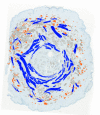Anatomy relevant to conservative mastectomy
- PMID: 26645002
- PMCID: PMC4646999
- DOI: 10.3978/j.issn.2227-684X.2015.02.06
Anatomy relevant to conservative mastectomy
Abstract
Knowledge of the anatomy of the nipple and breast skin is fundamental to any surgeon practicing conservative mastectomies. In this paper, the relevant clinical anatomy will be described, mainly focusing on the anatomy of the "oncoplastic plane", the ducts and the vasculature. We will also cover more briefly the nerve supply and the arrangement of smooth muscle of the nipple. Finally the lymphatic drainage of the nipple and areola will be described. An appreciation of the relevant anatomy, together with meticulous surgical technique may minimise local recurrence and ischaemic complications.
Keywords: Anatomy; conservative mastectomy; nipple; nipple-sparing.
Conflict of interest statement
Figures




References
-
- Cooper AP. editor. On the anatomy of the breast. London: Longman, 1840.
-
- Tot T. The theory of the sick breast lobe and the possible consequences. Int J Surg Pathol 2007;15:369-75. - PubMed
-
- Going JJ, Mohun TJ. Human breast duct anatomy, the 'sick lobe' hypothesis and intraductal approaches to breast cancer. Breast Cancer Res Treat 2006;97:285-91. - PubMed
-
- Mannino M, Yarnold J. Effect of breast-duct anatomy and wound-healing responses on local tumour recurrence after primary surgery for early breast cancer. Lancet Oncol 2009;10:425-9. - PubMed
Publication types
LinkOut - more resources
Full Text Sources
